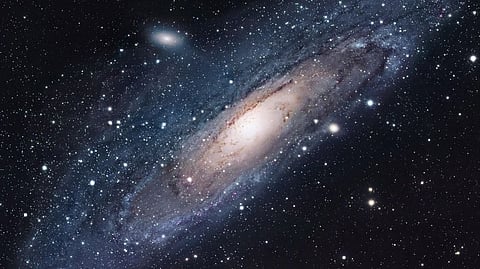
- Home
- न्यूजग्राम
- India
- World
- Politics
- Entertainment
- Culture
- Lifestyle
- Economy
- Sports
- Sp. Coverage
- Misc.
- NewsGram Exclusive
- Jobs / Internships

London, July 4, 2017: Astronomers have spotted a primitive galaxy, dubbed Little Cub, which they believe could reveal more about the chemical signature of the universe just minutes after the Big Bang.
The Little Cub galaxy – so called because it sits in the Ursa Major or Great Bear constellation – also offers the astronomers a rare chance to see galaxy demise as it starts to be consumed by a gigantic neighbouring galaxy.
The Little Cub and its larger neighbour, a grand design spiral galaxy called NGC 3359, are about 200,000 to 300,000 light years apart, and approximately 50 million light years from Earth, according to the study being presented at the Royal Astronomical Society's National Astronomy meeting in Britain on Tuesday.
Gas from the Little Cub is being stripped away by its interaction with NGC 3359, which has up to 10,000 times as many stars as the Little Cub and is similar to our Milky Way.
By observing this cosmic feast, scientists hope to understand more about how and when gas is lost from smaller galaxies.
We may be witnessing the quenching of a near-pristine galaxy as it makes its first passage about a Milky Way-like galaxy, said lead author Tiffany Hsyu from the University of California Santa Cruz, US.
It is rare for such a tiny galaxy to still contain gas and be forming stars when it is in close proximity to a much larger galaxy so this is a great opportunity to see just how this process works, Hsyu added.
Essentially the larger galaxy is removing the fuel that the Little Cub needs to form stars, which will eventually shut down star formation and lead to the smaller galaxy's demise, Hsyu explained.
The researchers also hope to gain an insight into the make-up of the very early Universe, by studying the hydrogen and helium atoms that are being illuminated by the small number of very bright stars within the Little Cub.
Since this galaxy is so primitive, it may still preserve the hydrogen and helium atoms that were created minutes after the Big Bang.
We know by studying the chemistry of the Little Cub that it is one of the most primitive objects currently known in our cosmic neighbourhood, said research co-author Ryan Cooke from Durham University in England.
Such galaxies, which have remained dormant for most of their lives, are believed to contain the chemical elements forged a few minutes after the Big Bang, Cooke added. (IANS)
